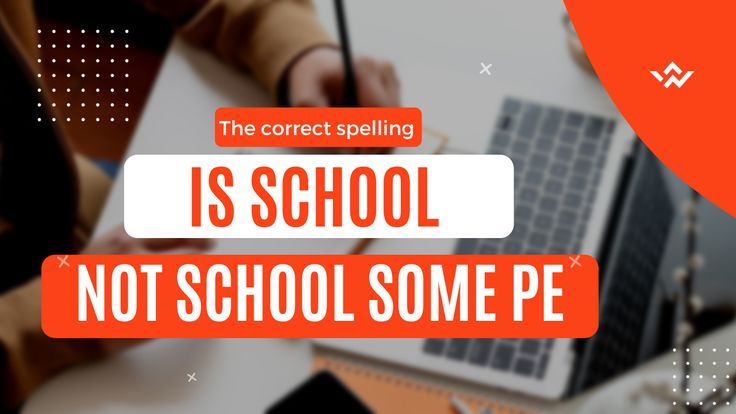Language is a living entity, evolving with time, culture, and usage. Words undergo transformations, spelling variations, and semantic shifts, reflecting the dynamic nature of human communication. In the vast tapestry of linguistic quirks, one such anomaly emerges: “the correct spelling is school not school. some pe – tymoff.” This seemingly paradoxical statement encapsulates a fascinating journey into the intricacies of language, spelling conventions, and human perception.
Understanding the Enigma: Deciphering the Anomaly
At first glance, the statement “the correct spelling is school not school. some pe – tymoff” appears contradictory, presenting two identical words separated by a seemingly arbitrary phrase. However, upon closer examination, the enigma begins to unravel, revealing layers of linguistic nuance and cognitive interpretation.
Exploring the Phenomenon: Ambiguity in Language
Language is rife with ambiguity, where words and phrases can carry multiple meanings or interpretations depending on context, syntax, and cultural conventions. In the case of “school not school,” the juxtaposition of identical words prompts cognitive dissonance, challenging conventional spelling norms and prompting linguistic introspection.
Unpacking the Intention: Semantic Intent vs. Phonemic Representation
Central to the anomaly of “school not school” is the interplay between semantic intent and phonemic representation. While the words themselves remain unchanged in their phonetic form, their semantic significance diverges, prompting a reevaluation of linguistic conventions and orthographic principles.
The Influence of Perception: Cognitive Processing and Linguistic Ambiguity
Human perception plays a pivotal role in decoding linguistic anomalies and reconciling semantic incongruities. The juxtaposition of “school not school” triggers cognitive dissonance, compelling individuals to reconcile conflicting interpretations and discern subtle nuances embedded within the statement.
Navigating Linguistic Evolution: Historical Context and Orthographic Conventions
The evolution of language is a testament to human creativity, adaptation, and cultural exchange. Throughout history, spelling conventions have undergone significant transformations, reflecting shifts in pronunciation, dialectical variations, and orthographic standards. The anomaly of “school not school” underscores the fluidity of language, inviting exploration into historical precedents and etymological roots.

The Role of Context: Pragmatics and Discourse Analysis
Context serves as a critical determinant in deciphering linguistic anomalies and unraveling semantic complexities. The interpretation of “school not school” hinges upon contextual cues, pragmatic inferences, and discourse analysis, highlighting the intricate interplay between language, culture, and communicative intent.
Semantic Paradoxes: Resolving Linguistic Contradictions
Linguistic paradoxes, such as “school not school,” challenge conventional modes of interpretation and prompt introspection into the nature of language and meaning. Resolving semantic contradictions requires a nuanced understanding of linguistic phenomena, cognitive processing, and communicative pragmatics.
Embracing Linguistic Diversity: Celebrating Variability in Spelling
Variability in spelling is emblematic of linguistic diversity and cultural richness. Across languages and dialects, spelling conventions vary, reflecting regional idiosyncrasies, historical influences, and phonetic nuances. The anomaly of “school not school” underscores the beauty of linguistic variability and the richness of human expression.
Unraveling Linguistic Mysteries: Exploring the Anomaly
The statement “the correct spelling is school not school. some pe – tymoff” presents a linguistic conundrum that invites further exploration and analysis. Embedded within this seemingly paradoxical statement are layers of linguistic complexity and cognitive intrigue, prompting us to delve deeper into the nuances of language, spelling conventions, and semantic interpretation.
Deciphering Linguistic Anomalies: A Cognitive Puzzle
At its core, the anomaly of “school not school” challenges conventional spelling norms and prompts us to reconsider our preconceived notions of orthographic correctness. By juxtaposing identical words with subtle variations in context, the statement invites cognitive dissonance and prompts us to reevaluate our understanding of spelling conventions and semantic interpretation.
Navigating Semantic Ambiguity: Unpacking Layers of Meaning
Central to the anomaly of “school not school” is the interplay between semantic ambiguity and phonetic representation. While the words themselves remain unchanged in their phonological form, their semantic significance diverges, prompting us to navigate the complexities of linguistic interpretation and discern subtle nuances embedded within the statement.
Cognitive Processing: Untangling Linguistic Paradoxes
Human perception plays a pivotal role in decoding linguistic paradoxes and reconciling semantic incongruities. The juxtaposition of “school not school” triggers cognitive dissonance, compelling us to reconcile conflicting interpretations and discern subtle layers of meaning embedded within the statement. Through introspection and cognitive processing, we unravel the intricacies of linguistic paradoxes and embrace the complexity of human language.
Interpreting Contextual Cues: Pragmatics in Linguistic Analysis
Context serves as a critical determinant in deciphering linguistic anomalies and unraveling semantic complexities. The interpretation of “school not school” hinges upon contextual cues, pragmatic inferences, and discourse analysis, highlighting the intricate interplay between language, culture, and communicative intent. By examining contextual clues and situational factors, we gain deeper insights into the nuances of linguistic interpretation and semantic pragmatics.
Historical Perspectives: Tracing the Evolution of Language
The evolution of language is a testament to human creativity, adaptation, and cultural exchange. Throughout history, spelling conventions have undergone significant transformations, reflecting shifts in pronunciation, dialectical variations, and orthographic standards. The anomaly of “school not school” underscores the fluidity of language, inviting exploration into historical precedents and etymological roots. By tracing the evolution of language, we gain a deeper appreciation for the dynamic nature of linguistic expression and the rich tapestry of human communication.
Navigating Linguistic Territories: Exploring Semantic Frontiers
Linguistic anomalies, such as “the correct spelling is school not school. some pe – tymoff,” challenge conventional modes of interpretation and prompt exploration into uncharted semantic territories. Resolving semantic contradictions requires a nuanced understanding of linguistic phenomena, cognitive processing, and communicative pragmatics. By embracing linguistic diversity and celebrating variability in spelling, we navigate the intricate landscapes of language with curiosity, humility, and reverence for the complexity of human expression.
Conclusion: Embracing Linguistic Complexity
In the tapestry of human language, anomalies such as “the correct spelling is school not school. some pe – tymoff” serve as poignant reminders of linguistic complexity and cognitive diversity. Through exploration, introspection, and dialogue, we gain deeper insights into the intricate workings of language, spelling conventions, and semantic interpretation. As we navigate the labyrinth of linguistic anomalies, we celebrate the richness of human expression and embrace the ever-evolving nature of language in all its complexity and beauty.
(FAQs)
Q: What does the statement “the correct spelling is school not school. some pe – tymoff” mean?
A: The statement “the correct spelling is school not school. some pe – tymoff” presents a linguistic anomaly that invites interpretation and analysis. It juxtaposes identical words with subtle variations in context, prompting cognitive dissonance and challenging conventional spelling norms. The intended meaning may vary based on individual interpretation and contextual understanding.
Q: Why does the statement “the correct spelling is school not school. some pe – tymoff” include seemingly contradictory elements?
A: The inclusion of seemingly contradictory elements in the statement “the correct spelling is school not school. some pe – tymoff” reflects the complexity of language and the nuances of linguistic interpretation. By juxtaposing identical words with subtle variations in context, the statement prompts us to reevaluate our understanding of spelling conventions, semantic interpretation, and cognitive processing.
Q: How can one interpret the anomaly of “school not school” in linguistic terms?
A: Interpreting the anomaly of “school not school” requires consideration of linguistic principles, cognitive processing, and contextual cues. While the words themselves remain unchanged in their phonetic form, their semantic significance diverges, prompting us to navigate the complexities of linguistic interpretation and discern subtle layers of meaning embedded within the statement.
Q: What role does context play in deciphering the anomaly of “school not school”?
A: Context serves as a critical determinant in deciphering linguistic anomalies and unraveling semantic complexities. The interpretation of “school not school” hinges upon contextual cues, pragmatic inferences, and discourse analysis, highlighting the intricate interplay between language, culture, and communicative intent.
Q: How can individuals navigate linguistic paradoxes and semantic ambiguities such as “the correct spelling is school not school. some pe – tymoff”?
A: Navigating linguistic paradoxes and semantic ambiguities requires a nuanced understanding of linguistic phenomena, cognitive processing, and communicative pragmatics. By examining contextual clues, historical perspectives, and situational factors, individuals can gain deeper insights into the nuances of linguistic interpretation and semantic pragmatics.

